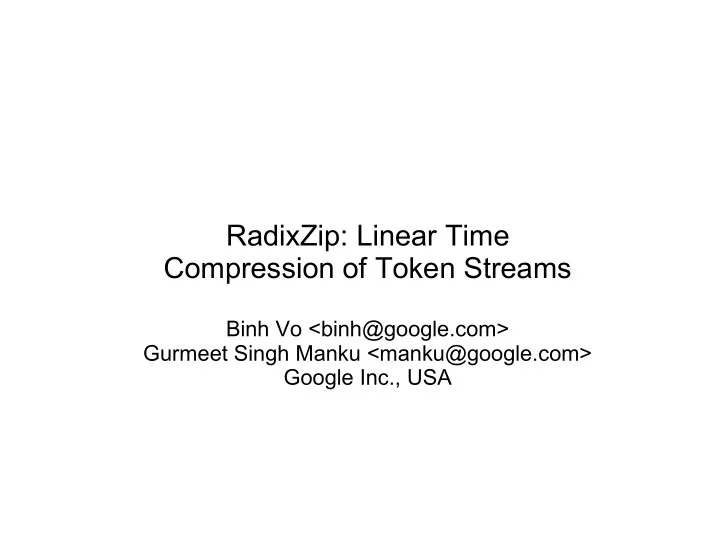

RadixZip: Linear Time Compression of Token Streams Binh Vo <binh@google.com> Gurmeet Singh Manku <manku@google.com> Google Inc., USA
Data of interest ● Collections of records: – Databases. – Logs (query or ad-clicks at Google). – Tables (telephone records at AT&T). ● Transposing into collections of columns. – Faster lookup of specific attributes. – Improved compression.
Context sorting compressors ● BZip - 1994 (Burrows, Wheeler, Seward). – General purpose compression. – Based on the BWT (suffix sorting). ● Vczip - 2004 (Vo and Vo). – Fixed width table compression. – Based on column dependency (predictor sorting). ● Common theme: sort data by some context. – A context is any string which helps 'predict' target. – Similar to sorting the target if prediction is accurate. – But reversible!
BWT: Suffixes as a context ● Transformed data is more compressible. – Bzip = BWT + Move-to-Front + Run-Length + Huffman
Column-specific properties ● Boundary awareness: – Byte indices. – Intra-token contexts. ● Multi-column context: – Dependency. – E.g. a user with a fixed IP and browser.
Token-specific redundancy ● Boundary awareness: – Byte indices. – Intra-token contexts. ● Multi-column context: – Dependency. – E.g. a user with a fixed IP and browser.
Token-specific redundancy ● Boundary awareness: – Byte indices. – Intra-token contexts. ● Multi-column context: – Dependency. – E.g. a user with a fixed IP and browser.
Token-specific redundancy ● Boundary awareness: – Byte indices. – Intra-token contexts. ● Multi-column context: – Dependency. – E.g. a user with a fixed IP and browser.
RadixZipTransform ● For each col i: – Sort by token prefixes formed from earlier columns. – Append reordered col i to output.
RadixZipTransform ● For each col i: – Sort by token prefixes formed from earlier columns. – Append reordered col i to output.
RadixZipTransform ● For each col i: – Sort by token prefixes formed from earlier columns. – Append reordered col i to output.
RadixZipTransform ● For each col i: – Sort by token prefixes formed from earlier columns. – Append reordered col i to output.
RadixZipTransform ● For each col i: – Sort by token prefixes formed from earlier columns. – Append reordered col i to output.
Linear Time ● Perform a Radix sort. ● Append one column before each iteration.
Linear Time ● Perform a Radix sort. ● Append one column before each iteration.
Linear Time ● Perform a Radix sort. ● Append one column before each iteration.
Linear Time ● Perform a Radix sort. ● Append one column before each iteration.
Compression benefits ● Preserves byte columns. ● Context sorted, but limited to token boundaries. ● Transformed data is more compressible: – RadixZip = RadixZipTransform + MTF + RLE + Huffman
Performance ● Linear time complexity. ● Memory properties: – Requires 8 bytes per token. – Cache-friendly. ● Comparison to BWT: – Faster than currently known BWT implementations. – Similarly, using less memory. – RadixZip is simple to implement, robust code.
Inter-column dependency ● Passing permutations equivalent to presorting. ● Passed permutations continue to propagate.
RadixZip vs Bzip2 (census data) ● US population survey. – Fixed-width fields. – Divided by field. ● RadixZip outperforms on larger columns. ● Loss on smaller ones, – Likely due to needing more byte-columns to 'ramp up'. ● About 15% total gain.
RadixZip vs Bzip2 (census data) ● Compression speed improves: – Especially on highly compressible streams, – Since Bzip2's alg is worst-case quadratic. ● Decompression speed improves. ● Most outliers are on very small streams.
Dependency results ● Hand-picked dependencies from census data. ● Use of a predictor can reduce compressed size to ~0. ● High dependency indicates little to no new information.
Conclusion ● RadixZipTransform - a linear time transform. ● Improvement in both performance and compression for token streams over general purpose compressors. ● Efficient exploitation of stream correlation.
Recommend
More recommend